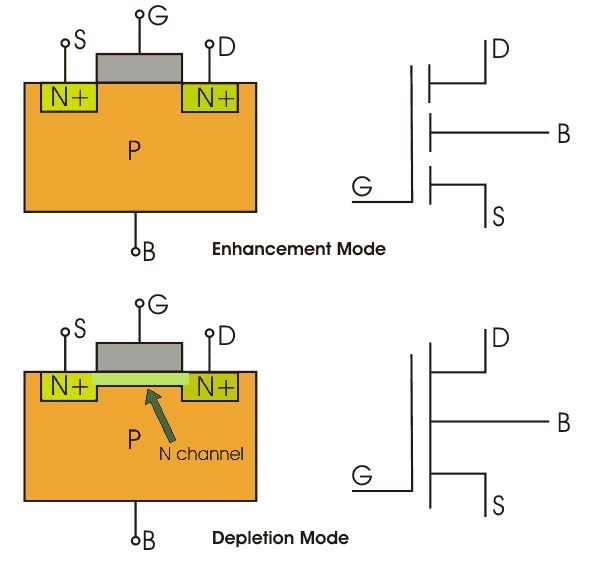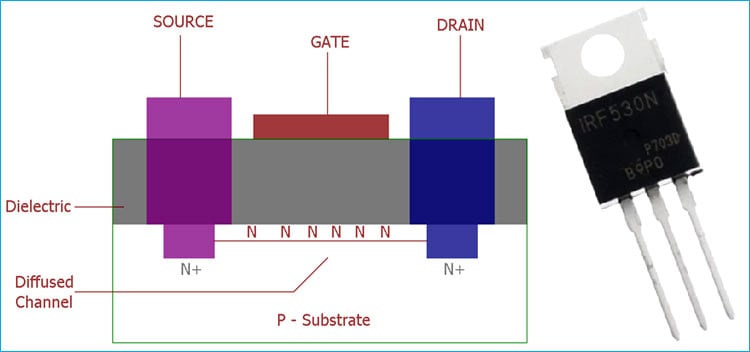In P-channel D-MOSFET, The source, drain, and channel is made up of P-type material upon an N-type substrate. P-channel has holes as the charge carrier. Therefore, to reduce the channel width or to attract electrons from the N-substrate, P-channel MOSFET is applied with positive gate voltage V GS. The behavior of an enhancement p-channel metal-oxide field-effect transistor (pMOSFET) is largely controlled by the voltage at the gate (usually a negative voltage).
A MOSFETs exhibit three regions of operation viz., Cut-off, Linear or Ohmic and Saturation. Among these, when MOSFETs are to be used as amplifiers, they are required to be operated in their ohmic region wherein the current through the device increases with an increase in the applied voltage. On the other hand, when the MOSFETs are required to function as switches, they should be biased in such a way that they alter between cut-off and saturation states. This is because, in cut-off region, there is no current flow through the device while in saturation region there will be a constant amount of current flowing through the device, just mimicking the behaviour of an open and closed switch, respectively. Download itunes 12 for mac. This functionality of MOSFETs is exploited in many electronic circuits as they offer higher switching rates when compared to BJTs (bipolar junction transistors).
Figure 1 shows a simple circuit which uses an n-channel enhancement MOSFET as a switch. Here the drain terminal (D) of the MOSFET is connected to the supply voltage VS via the drain resistor RD while its source terminal (S) is grounded. Further, it has an input voltage Vi applied at its gate terminal (G) while the output Vo is drawn from its drain.
Now consider the case where Vi applied is 0V, which means the gate terminal of the MOSFETis left unbiased. As a result, the MOSFET will be OFF and operates in its cutoff region wherein it offers a high impedance path to the flow of current which makes the IDS almost equivalent to zero. As a result, even the voltage drop across RD will become zero due to which the output voltage Vo will become almost equal to VS.
Next, consider the case where the input voltage Vi applied is greater than the threshold voltage VT of the device. Under this condition, the MOSFET will start to conduct and if the VS provided is greater than the pinch-off voltage VP of the device (usually it will be so), then the MOSFET starts to operate in its saturation region. This further means that the device will offer low resistance path for the flow of constant IDS, almost acting like a short circuit. As a result, the output voltage will be pulled towards low voltage level, which will be ideally zero.

From the discussion presented, it is evident that the output voltage alters between VS and zero depending on whether the input provided is less than or greater than VT, respectively. Thus, it can be concluded that MOSFETs can be made to function as electronic switches when made to operate between cut-off and saturation operating regions.
Download html5 player for mac. Similar to the case of n-channel enhancement type MOSFET, even n-channel depletion type MOSFETs can be used to perform switching action as shown by Figure 2. The behaviour of such a circuit is seen to be almost identical to that explained above except the fact that for cut-off, the gate voltage VG needs to be made negative and should be lesser than -VT.
Next, Figure 3 shows the case wherein the p-channel enhancement MOSFET is used as a switch. Here it is seen that the supply voltage VS is applied at its source terminal (S) and the gate terminal is provided with the input voltage Vi while the drain terminal is grounded via the resistor RD. Further the output of the circuit Vo is obtained across RD, from the drain terminal of the MOSFET.
In the case of p-type devices the conduction current will be due to holes and will thus flow from source to drain ISD, and not from drain to source (IDS) as in the case of n-type devices. Now, let us assume that the input voltage which is nothing but the gate voltage VG of the MOSFET goes low. This causes the MOSFET to switch ON and to offer a low (almost negligible) resistance path to the current flow. As a result heavy current flows through the device which results in a large voltage drop across the resistor RD. This inturn results in the output which is almost equal to the supply voltage VS.

Next, consider the case where Vi goes high i.e. when Vi will be greater than the threshold voltage of the device (VT will be negative for these devices). Under this condition, the MOSFET will be OFF and offers a high impedance path for the current flow. This results in almost zero current leading to almost zero voltage at the output terminal.

Similar to this, even p-channel depletion-type MOSFETs can be used to perform switching action as shown by Figure 4. The working of this circuit is almost similar to the one explained above except for the fact that here the cut-off region is experienced only if Vi = VG is made positive such that it exceeds the threshold voltage of the device.

The table presented below summarizes the discussion presented above.
Comparison of N Channel and P Channel MOSFETs
- The P-channel enhancement MOSFETs were very popular, because it was much easier and cheaper to produce than the N channel device.
But now a days these difficulties have overcome and mass production of N-channel MOSFETs becomes easier.
Thus the N-MOSFETS have replaced PMOSs and P-MOSFETs have almost become obsolete. - The hole mobility is nearly 2.5 times lower than the electron mobility.
Thus a P channel MOSFET occupies a larger area than the N channel MOSFET having the same ID rating.
At normal fields, in silicon,
the hole mobility is 500 cm2/v.sec
the electron mobility is 1300 cm2/v.sec.
Therefore the P-channel ON resistance will be twice that of n-channel MOSFET ON resistance.
Remember:
- ON resistance means the resistance of the device when ID is maximum for a given VDS. Its value depends upon μ of carriers.
- P-channel device have holes as majority carriers.
- N-channel device have electrons as majority carriers.
- At the same values of ID and VDS, if the ON resistance of P channel device were to be reduced/make equal to that of N-channel device, then the P-channel device must have more than twice the are of N-channel device. Thus the n -channel devices will be smaller is size.
In other words the packing density of N-channel devices is more (R = ρ. l/ A) - N channel MOSFETs are fast switching devices. The operating speed is limited by RC time constant of the device. The capacitance is proportional to the junction cross sections.
- The N channel MOSFETs are TTL compatible. As the applied gate voltage and drain supply are positive for an n-channel enhancement MOSFET.
- The drain resistance of P channel MOSFET is 3 times higher than that for an identical N-channel MOSFET.
- The N-Channel MOSFET has the higher packing density which makes it faster in switching applications due to the smaller junction areas and lower inherent capacitance.
- The N-channel MOSFET is smaller for the same complexity than P-channel device.
- Due to the positively charged contaminants, the N-channel MOSFET may turn ON prematurely, whereas the P-channel device will not be affected.
The summary of Difference Between N Channel and P Channel MOSFETs are listed in the following table.
| N-Channel MOSFET | P-Channel MOSFET |
| Have higher packing density, leads to small size | Comparatively low packing density. |
| Smaller in size for same complexity | Size will be more. |
| High switching device. (mobility of electrons is high) | Low switching speed. (mobility of holes is low) |
| Low ON resistance | High ON resistance. |
P Channel Enhancement Type Mosfet Tool
Thanks for reading about Difference Between N Channel and P Channel MOSFETs.. Please don't leave page instantly. Please leave your comments below.. It will take hardly few seconds 🙂
P Channel Enhancement Type Mosfet Test
You may also like to read:
P Type Mosfet Circuits
MOSFET vs JFET Comparison
What is the Difference Between BJT and FET?
What is the difference between Schottky Diode and PN Junction diode?
